Houston, vi har haft et problem:at huske Apollo 13 på 50
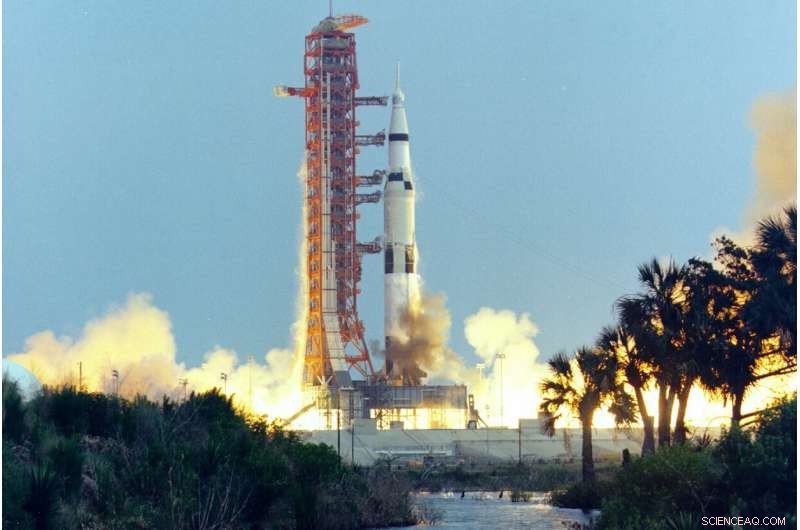
I denne 11. april, Foto fra 1970 gjort tilgængeligt af NASA, Saturn V-raketten, der transporterer besætningen på Apollo 13-missionen til månen, opsendes fra Kennedy Space Center i Florida. (NASA via AP)
Apollo 13's astronauter tænkte aldrig over deres missionsnummer, da de for 50 år siden eksploderede mod månen. Selv da deres ilttank gik i stykker to dage senere - den 13. april.
Jim Lovell og Fred Haise insisterer på, at de ikke er overtroiske. De bruger endda 13 i deres e-mailadresser.
Som missionskommandant Lovell ser det, han er utrolig heldig. Ikke nok med at han overlevede NASAs mest rystende måneskud, han er her for at markere dets gyldne jubilæum.
"Jeg er stadig i live. Så længe jeg kan blive ved med at trække vejret, Jeg er god, " Lovell, 92, sagde i et interview med The Associated Press fra hans Lake Forest, Illinois, hjem.
Et halvt århundrede senere, Apollo 13 betragtes stadig som Mission Controls fineste time.
Lovell kalder det "en mirakuløs bedring."
Haise, som så mange andre, betragter det som NASAs mest succesrige fiasko.
"Det var en stor mission, "Haise, 86, sagde. Det viste "hvad der kan gøres, hvis folk bruger deres sind og lidt opfindsomhed."
Som månemodulets pilot, Haise ville være blevet den sjette mand, der gik på månen, efter Lovell på den støvede grå overflade. Iltbeholdereksplosionen fratog dem månelandingen, som ville have været NASAs tredje, ni måneder efter Apollo 11's Neil Armstrong og Buzz Aldrin tog menneskehedens første fodspor på månen.
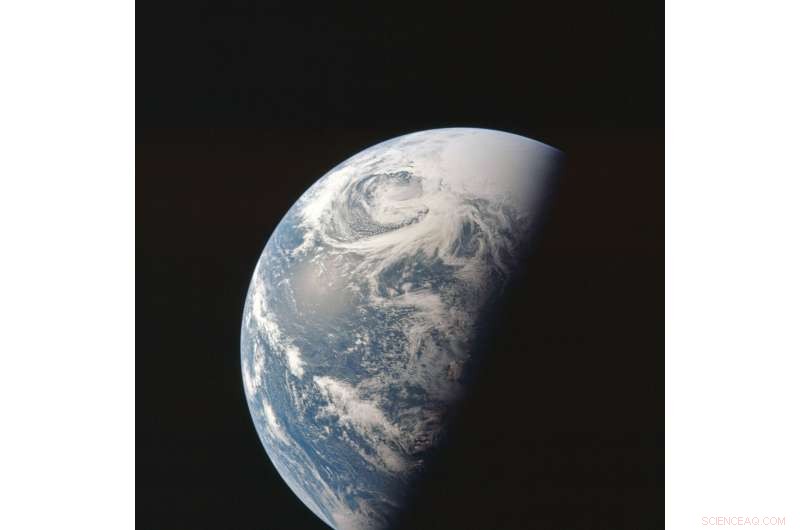
Dette foto fra april 1970, der blev gjort tilgængeligt af NASA, viser Jorden, mens Apollo 13-missionen går mod månen. (NASA via AP)
Nu har coronavirus-pandemien frarøvet dem deres jubilæumsfejring. Festlighederne er sat i bero, blandt andet i Kennedy Space Center i Florida, hvor missionen begyndte den 11. april, 1970, en lørdag ligesom i år.
Det vil ikke stoppe Haise, som stadig bor i Houston, fra at markere det, han kalder "boom-dag" næste mandag, som han gør hver 13. april.
Lovell, Haise og Jack Swigert, en udfyldning i sidste øjeblik, der døde i 1982, var næsten til månen, da de hørte et brag og mærkede et gys. En af to ilttanke var sprængt i rumfartøjets servicemodul.
De spændte ord, der fulgte, er ting med plads - og film - berømmelse.
"OKAY, Houston, vi har haft et problem her, "radioede Swigert, kommandomodulets pilot.
"Dette er Houston. Sig igen, Vær venlig."
"Houston, vi har haft et problem, " Lovell skar ind.
Lovell rapporterede et pludseligt spændingsfald i et af de to elektriske hovedkredsløb. Inden for sekunder, Houstons Mission Control så trykaflæsninger for den beskadigede iltbeholder dykke til nul. Eksplosionen slog også to elektriske energigenererende brændselsceller ud og beskadigede den tredje.
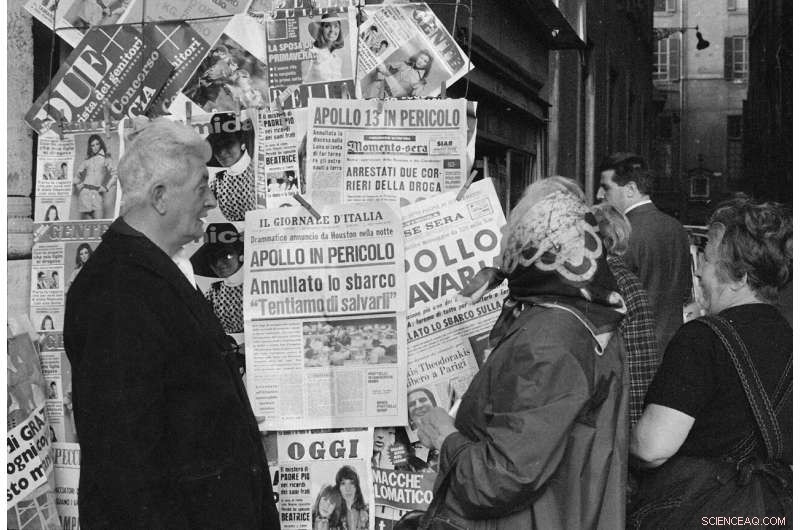
I denne 14. april, 1970 fil foto, folk i Rom kigger på aviser, der fortæller om de problemer, der udviklede sig ombord på USA's Apollo 13-mission, som førte til aflysningen af forsøget på at lande på månen. (AP Foto)
Da Lovell kiggede ud af vinduet og så ilt slippe ud i det sorte tomrum, han vidste, at hans månelanding også gled væk. Han skubbede alle følelser til side.
"At ikke lande på månen eller dø i rummet er to forskellige ting, " Lovell forklarede, "og så glemte vi at lande på månen. Dette var en overlevelse. Hvordan kommer vi hjem?"
Astronauterne var 200, 000 miles (322, 000 kilometer) fra Jorden. At komme tilbage i live ville kræve ro, dygtighed og, Ja, held.
"Eksplosionen kunne ikke være sket på et bedre tidspunkt, " sagde Lovell.
Meget tidligere, han sagde, og astronauterne ville ikke have haft nok elektrisk kraft til at komme rundt om månen og slangebøsse tilbage til Jorden for et splashdown. Et eksplosion i månens kredsløb eller, Stadig værre, mens Lovell og Haise var på overfladen, "det ville være enden på det."
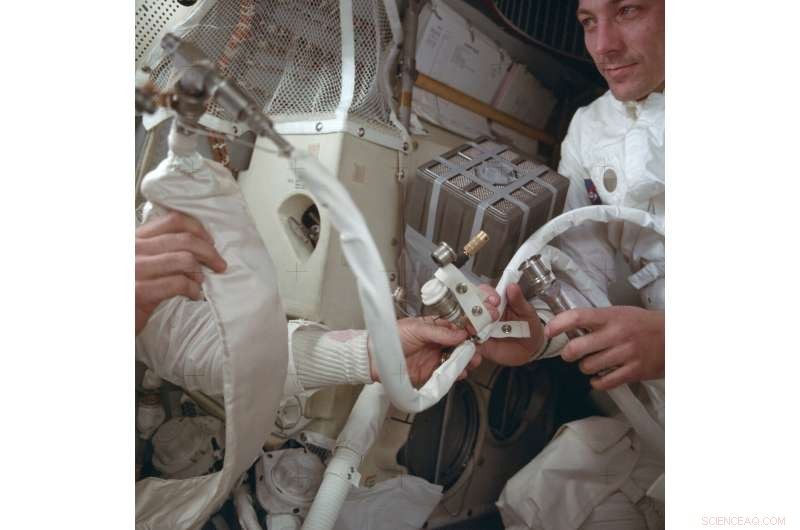
På dette foto fra april 1970 leveret af NASA, Apollo 13 kommandomodulpilot John Swigert hjælper med at tilslutte en lithiumhydroxidbeholder i månemodulet, i et forsøg på at slippe af med kuldioxid i kabinen, da rumfartøjet forsøger at vende tilbage til Jorden. Eksplosionen af en ilttank i servicemodulet tvang den tre mand store besætning til at stole på månemodulet som en "redningsbåd". (NASA via AP)
"Jeg tror, vi fik noget guddommelig hjælp i denne flyvning, " sagde Lovell.
Den afbrudte mission gik fra at være så besværlig, at ingen af de store tv-netværk sendte astronauternes show-and-tell minutter før eksplosionen, til et drama på liv og død, der griber hele verden.
Da flydirektør Gene Kranz og hans team i Houston løb for at komme med en redningsplan, astronauterne holdt sig kolde. Det var Lovells fjerde rumflyvning - hans anden til månen - og den første og eneste for Haise og Swigert.
Mørke tanker "susede altid gennem vores sind, men lydløst. Det talte vi ikke om " sagde Lovell.
Tilføjede Haise:"Vi nåede aldrig det punkt, hvor der ikke var noget tilbage at gøre. Så, ingen, vi nåede aldrig til et punkt, hvor vi sagde, 'Godt, vi skal dø.'"
Det Hvide Hus, mindre selvsikker, krævede odds. Kranz nægtede, overlader det til andre at sætte besætningens chancer på 50-50. I hans sind, der var ingen tvivl, ingen plads til fiasko - kun succes.
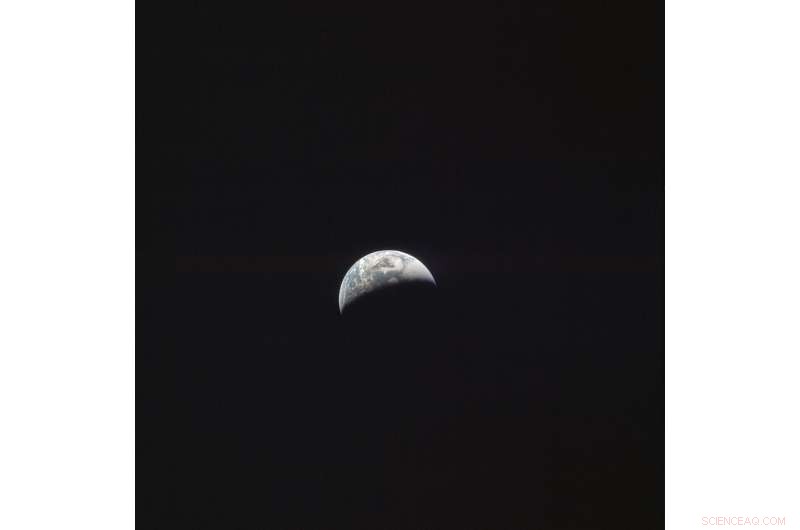
Dette foto fra april 1970, der blev gjort tilgængeligt af NASA, viser Jorden, da Apollo 13-besætningen rejste mod månen. (NASA via AP)
"Dybest set var det navnet på spillet:Jeg har tænkt mig at få dem hjem. Mit hold vil få dem hjem. Vi får dem hjem, " huskede Kranz.
For ordens skyld, Kranz udtalte aldrig "fejl er ikke en mulighed." Linjen er ren Hollywood, skabt til filmen "Apollo 13" fra 1995 med Ed Harris som Kranz og Tom Hanks som Lovell.
Flyvelederne gik i krisetilstand. De beordrede øjeblikkeligt kommandomodulet Odyssey at lukke ned for at bevare den lille strøm, der var tilbage, og astronauterne til at flytte ind i månemodulet Aquarius, nu en redningsbåd.
Et af lavpunkterne, Lovell sagde, var klar over, at de ville blive trange sammen i landeren.
"Det var designet til to personer i to dage. Vi var tre personer i fire dage."
Overbelastning af kuldioxid, fra vejrtrækning, truede med at dræbe dem.
Ingeniører forsøgte at finde ud af, hvordan de kunne omdanne de firkantede luftrensende dåser i den døde kapsel til runde, der ville passe ind i deres midlertidige hjem.
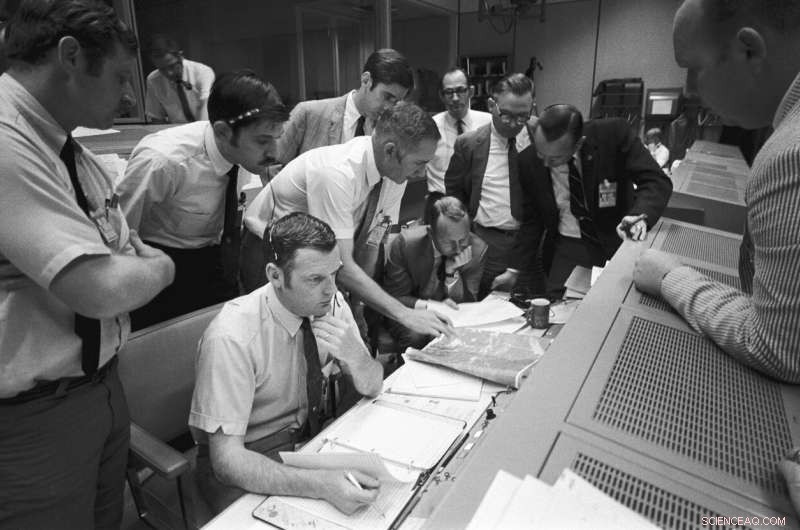
I denne 15. april, Foto fra 1970 gjort tilgængeligt af NASA, en gruppe flyvekontrollører samles omkring Glenn S. Lunneys konsol, siddende i forgrunden, Skift 4 flyvedirektør, in the Mission Operations Control Room (MOCR) of Mission Control Center (MCC) in Houston. Their attention is drawn to a weather map of the proposed landing site in the Pacific Ocean. På dette tidspunkt, the Apollo 13 lunar landing mission had been canceled, and the problem-plagued Apollo 13 crew members were in trans-Earth trajectory attempting to bring their crippled spacecraft back home. (NASA via AP)
Their outside-the-box, seat-of-the-pants solution, using spacecraft scraps, worked. But it was so damp and cold that the astronauts couldn't sleep. Condensation covered the walls and windows, and the temperature was close to freezing.
Dehydrated and feverish, Haise had the roughest time during the six-day ordeal. Despite the sky-high stress, Haise recalls no cross words among the three test pilots. Even Swigert fit in, despite joining the crew a scant three days before liftoff. He replaced command module pilot Ken Mattingly, who with his crewmates had been exposed to German measles, but unlike them didn't have immunity.
Rumors swirled that the astronauts had poison pills tucked away in case of a hopeless situation. Lovell dispelled that notion on page one of his 1994 autobiography, "Lost Moon, " the basis for the "Apollo 13″ film.
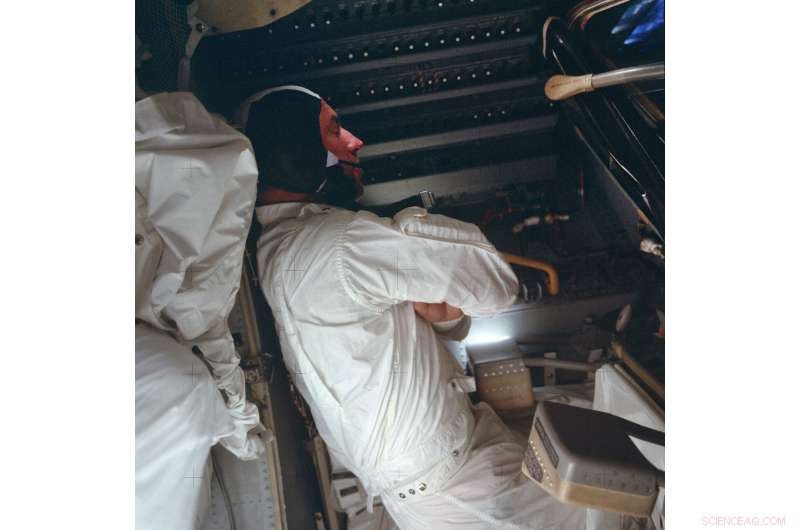
This April 1970 photo made available by NASA shows astronaut Jim Lovell during the Apollo 13 mission. (NASA via AP)
Splashdown day finally arrived April 17, 1970—with no guarantees.
The astronauts managed to power up their command module, avoiding short circuits but creating a rainfall inside as the spacecraft decelerated in the atmosphere.
The communication blackout lasted 1 1/2 minutes longer than normal. Controllers grew alarmed. Endelig, three billowing parachutes appeared above the Pacific. It was only then, Lovell said, that "we knew that we had it made."
The astronauts had no idea how much their cosmic cliffhanger impacted the world until they reached Honolulu. President Richard Nixon was there to greet them.
"We never dreamed a billion people were following us on television and radio, and reading about us in banner headlines of every newspaper published, " Lovell noted in a NASA history.
The tank explosion later was linked to damage caused by electrical overheating in ground tests.
-
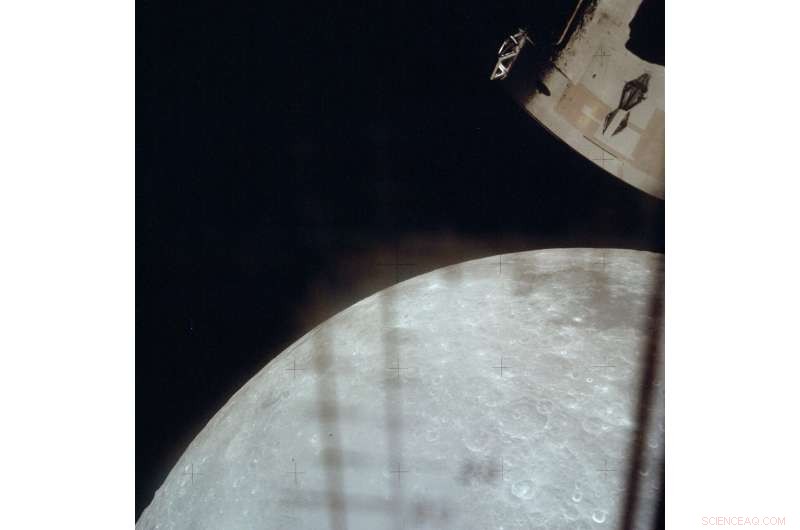
This April 1970 photo made available by NASA shows the moon through a window on the lunar module as the Apollo 13 crew heads back towards the Earth. (NASA via AP)
-
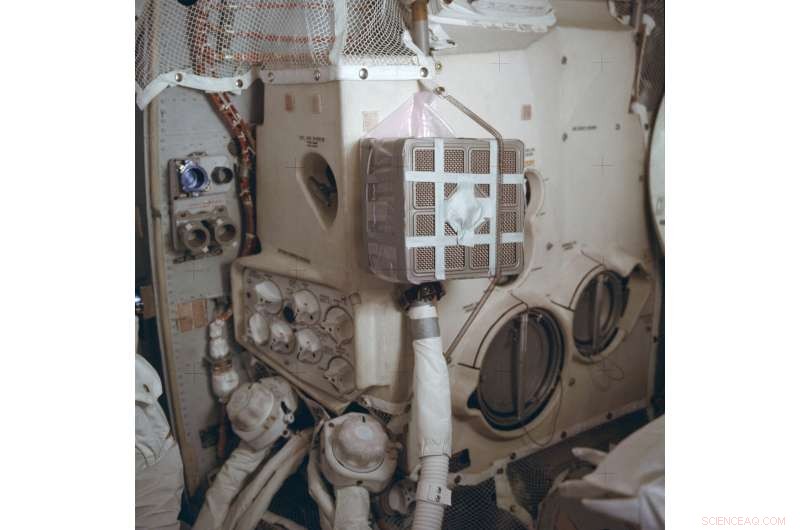
This April 1970 photo made available by NASA shows the interior of the Apollo 13 lunar module with the "mail box, " an ad hoc device which the crew assembled while in space to remove carbon dioxide from the air. It was designed and tested on the ground in Houston. Because of the explosion of one of the oxygen tanks in the service module, the three men had to use the lunar module as a "lifeboat" on their way back to Earth. (NASA via AP)
-
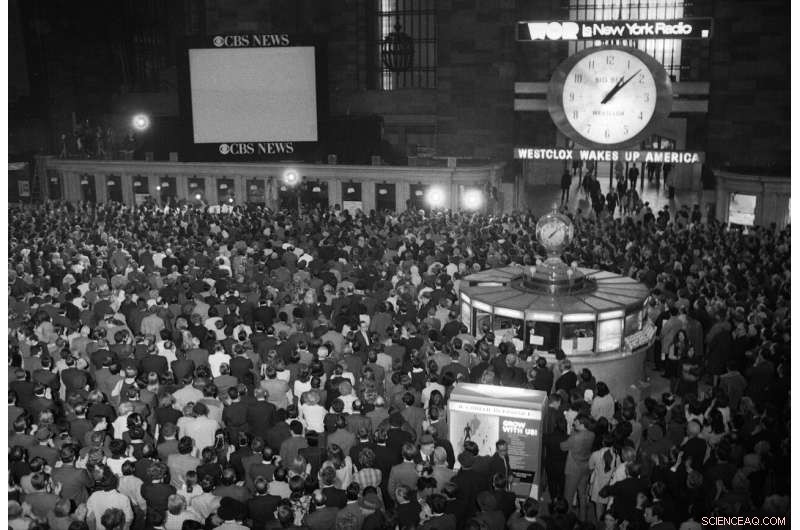
In this April 17, 1970 file photo, crowds watch a television screen in New York's Grand Central Station waiting for the safe arrival of the Apollo 13 astronauts in the Pacific Ocean. (AP Photo/J. Spencer Jones)
-
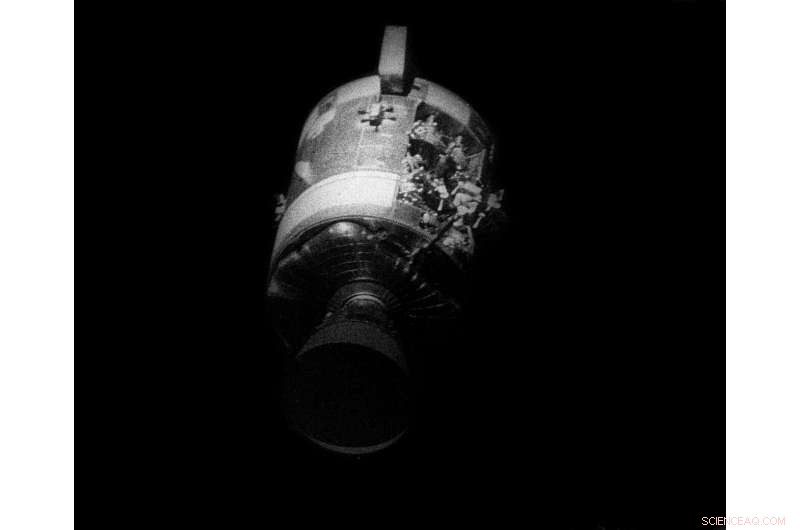
This April 17, 1970 photo made available by NASA shows the severely damaged Apollo 13 service module after separation from the lunar module/command module. An entire panel on the service module was blown away by the explosion of an oxygen tank. The damage forced the Apollo 13 crew members to use the lunar module as a "lifeboat." The lunar module was jettisoned just prior to Earth re-entry by the command module. (NASA via AP)
-
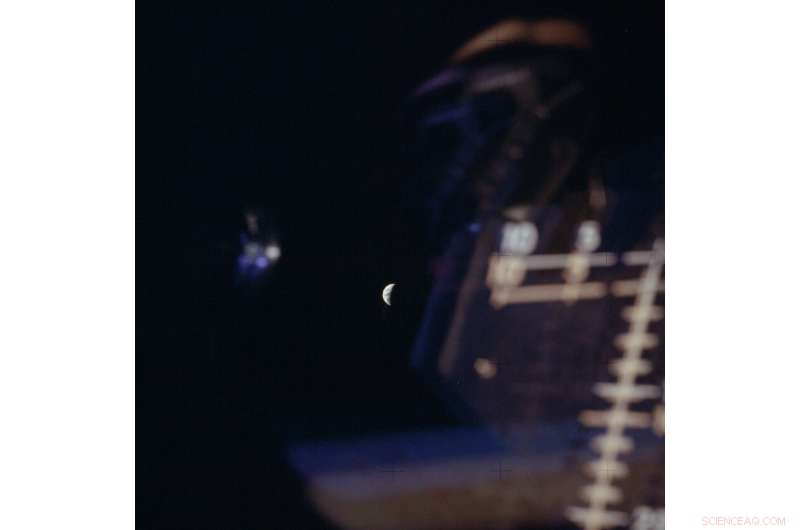
In this April 1970 photo made available by NASA, the Earth is seen though a window on the lunar module as the Apollo 13 crew heads towards home. (NASA via AP)
-
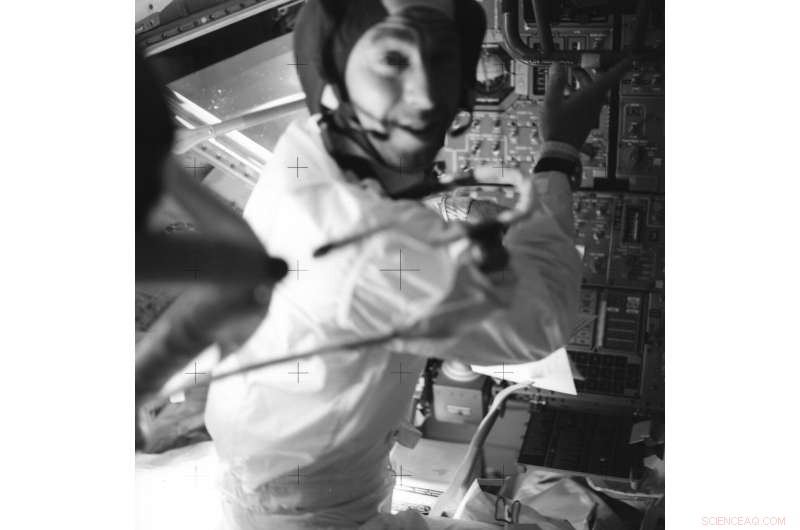
In this April 17, 1970 photo made available by NASA, astronaut Jim Lovell, inside the Apollo 13 lunar module, prepares it for jettison before returning to the command module for splashdown in the Pacific Ocean. (NASA via AP)
-
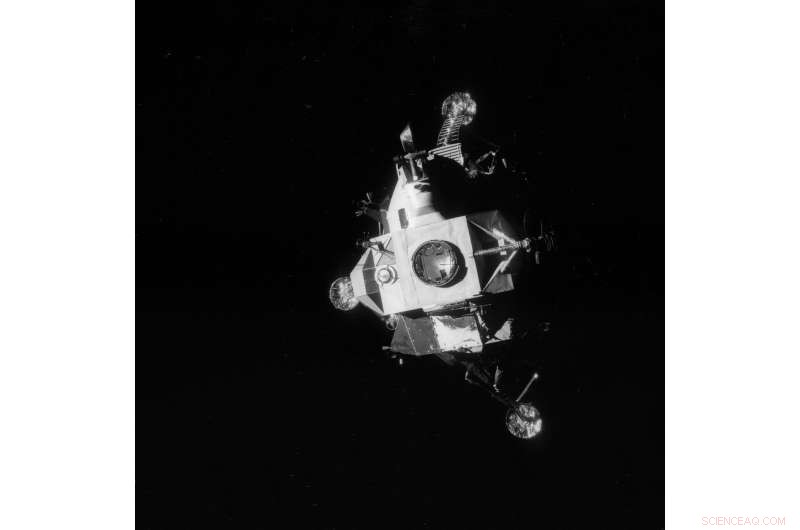
This April 17, 1970 photo provided by NASA shows the Apollo 13 lunar module photographed from the command module just after the lunar module was jettisoned, about an hour before splashdown of the command module in the Pacific Ocean. The explosion of an oxygen tank in the service module forced the Apollo 13 crew members to rely on the lunar module as a "lifeboat." (NASA via AP)
-

In this April 17, 1970 photo made available by NASA, astronaut Jim Lovell, kommandør, is hoisted aboard a helicopter from the USS Iwo Jima, after splashdown of the Apollo 13 command module in the Pacific Ocean. (NASA via AP)
-
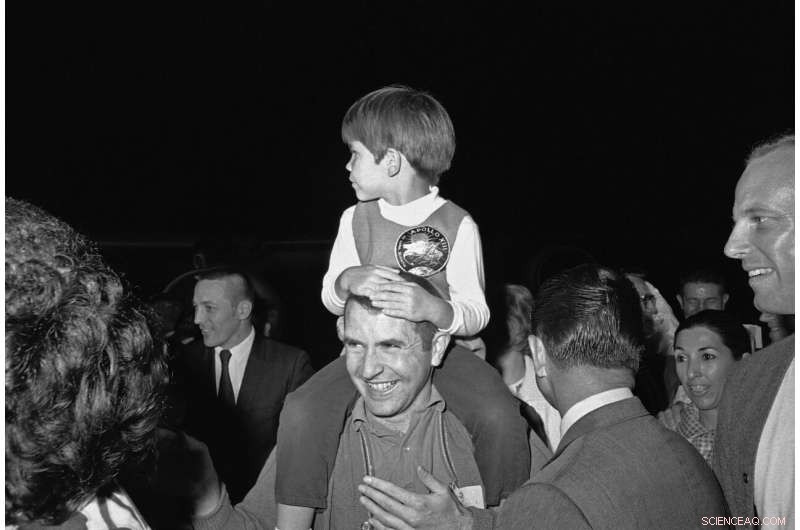
In this April 19, 1970 file photo, Apollo 13 astronaut Jim Lovell carries his son, Jeff, 4, on his shoulders as he arrived at Ellington Air Force Base in Houston. (AP Foto)
-
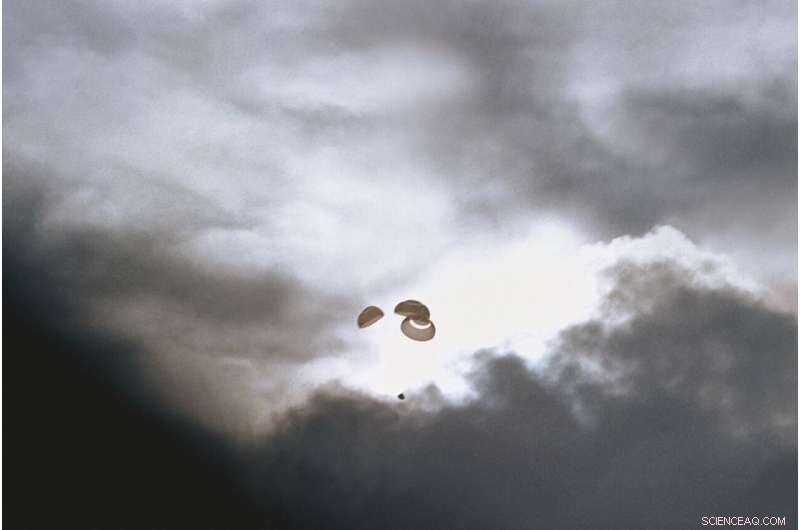
In this April 17, 1970 photo made available by NASA, the command module carrying the Apollo 13 crew parachutes to a splashdown in the Pacific Ocean. (NASA via AP)
-
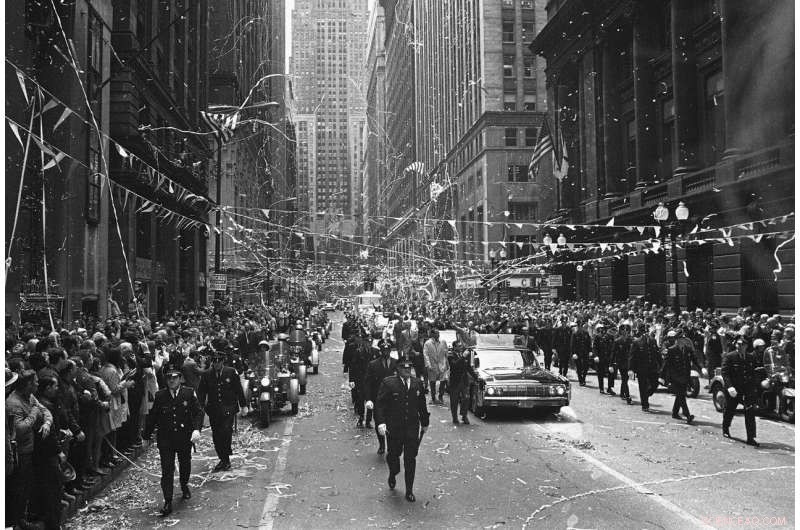
In this May 1, 1970 file photo, confetti falls from the skyscrapers in Chicago's financial district as Apollo 13 astronauts John Swigert and Jim Lovell ride in a motorcade during a parade in their honor. (AP Foto)
-
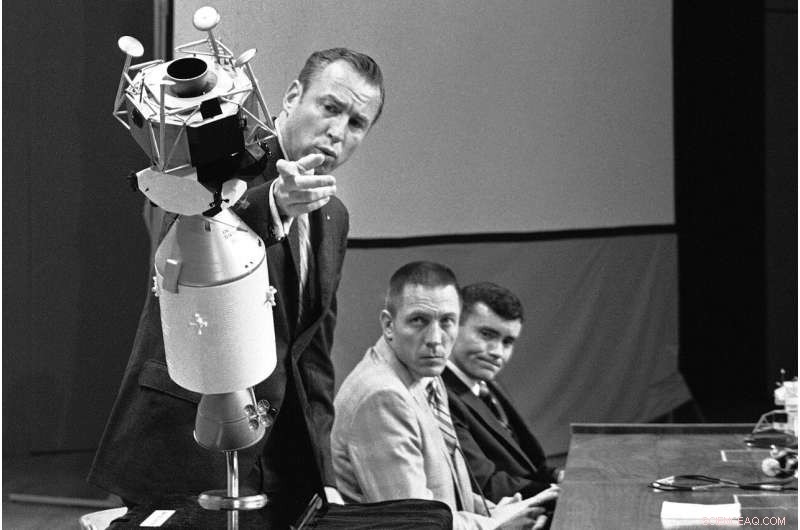
In this April 21, 1970 file photo, Apollo 13 commander Jim Lovell uses a scale model during a televised news conference at the Manned Spacecraft Center, Houston to explain how the crew managed to survive after the explosion that damaged the service module during their mission to the moon. At center is John Swigert, command module pilot, and at right is Fred Haise, lunar module pilot. (AP Foto)
-
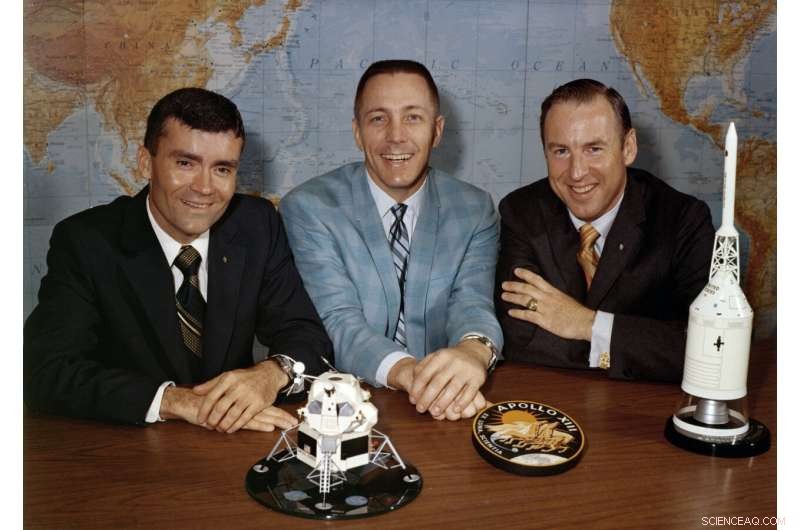
In this April 10, 1970 photo made available by NASA, Apollo 13 astronauts, from left, Fred Haise, Jack Swigert and Jim Lovell gather for a photo on the day before launch. (NASA via AP)
Apollo 13 "showed teamwork, camaraderie and what NASA was really made of, " said Columbia University's Mike Massimino, a former shuttle astronaut.
In the decades since, Lovell and his wife, Marilyn, of nearly 68 years have discussed the what-ifs and might-have-beens.
"The outcome of everything is, naturligt, that he's alive, " hun sagde, "and that we've had all these years."
© 2020 The Associated Press. Alle rettigheder forbeholdes. Dette materiale må ikke offentliggøres, udsende, omskrevet eller omfordelt uden tilladelse.
 Varme artikler
Varme artikler
-
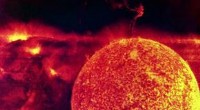 Kunne en ekstremt kraftig solblus ødelægge al elektronik på jorden?Dette foto fra NASA fanger et soludbrud i aktion. Se flere solpletbilleder. NASA Glenn Research Center (NASA-GRC) En sang skrevet af Hy Zaret og Lou Singer, senere populariseret af bandet They Might
Kunne en ekstremt kraftig solblus ødelægge al elektronik på jorden?Dette foto fra NASA fanger et soludbrud i aktion. Se flere solpletbilleder. NASA Glenn Research Center (NASA-GRC) En sang skrevet af Hy Zaret og Lou Singer, senere populariseret af bandet They Might -
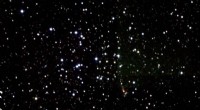 Astronomer udfører en omfattende undersøgelse af den unge åbne klynge NGC 1960Åben klynge NGC 1960. Kredit:2MASS/UMass/IPAC-Caltech/NASA/NSF. Indiske astronomer har udført en omfattende fotometrisk, kinematisk og variabilitetsundersøgelse af en ung åben hob kendt som NGC 19
Astronomer udfører en omfattende undersøgelse af den unge åbne klynge NGC 1960Åben klynge NGC 1960. Kredit:2MASS/UMass/IPAC-Caltech/NASA/NSF. Indiske astronomer har udført en omfattende fotometrisk, kinematisk og variabilitetsundersøgelse af en ung åben hob kendt som NGC 19 -
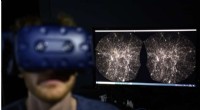 Store billede, big data:Schweiz afslører universets VR-softwareHadrien Gurnel, softwareingeniør EPFLs Laboratory for Experimental Museology (eM+) udforsker med en virtual reality-hjelm det mest detaljerede 3D-kort over universet med virtual reality-softwaren VIRU
Store billede, big data:Schweiz afslører universets VR-softwareHadrien Gurnel, softwareingeniør EPFLs Laboratory for Experimental Museology (eM+) udforsker med en virtual reality-hjelm det mest detaljerede 3D-kort over universet med virtual reality-softwaren VIRU -
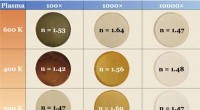 Uklarheden af exoplanetatmosfærer afhænger af egenskaberne af aerosolpartiklerForskere målte brydningsindekserne ved synlige bølgelængder (n) for uklarhedsprøver skabt under en række forhold. Kredit:Yu et al., Natur astronomi, 2021 Mange exoplaneter har uigennemsigtige atmo
Uklarheden af exoplanetatmosfærer afhænger af egenskaberne af aerosolpartiklerForskere målte brydningsindekserne ved synlige bølgelængder (n) for uklarhedsprøver skabt under en række forhold. Kredit:Yu et al., Natur astronomi, 2021 Mange exoplaneter har uigennemsigtige atmo
- Hvad står HSS for i stål?
- Undersøgelse sår tvivl om opvarmningsimplikationer af brun kulstofaerosol fra skovbrande
- Laserlys gør et comeback (bogstaveligt talt)
- NASAs Operation IceBridge afslutter 11 års polarundersøgelser
- At finde åbent vand i Grønlands iskolde hav
- Det sydøstlige Queensland er mere tørt og oversvømmet, end vi troede


